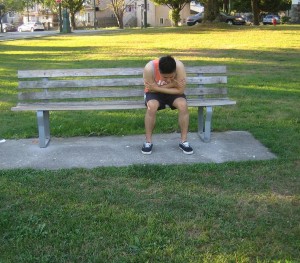After sustaining an injury to the chest or forceful coughing, there is the possibility of broken ribs if the individual has any of the following:
- Intense pain while taking a breath
- Crepitus or “crunch-like” sensation under the skin
- Tenderness to the chest area or back over the rib area
The ideal way to identify a broken rib is through the mechanism of injury. Being struck in the chest, falling on an object or striking or smashing the chest into the dashboard or steering wheel during a vehicular accident can result to broken ribs.
Even forceful coughing can be considered as a mechanism for broken ribs. In rare circumstances, a region of the ribcage detaches from the surrounding muscle and bone. This region loses its stable structure and moves quite easily as the individual breathes. The region is called as a flail segment and considered dangerous than a simple case of broken ribs

Take note that the ribs are hard to break since they are enclosed by strong muscles and can endure a lot of pressure before they eventually crack. The elderly can end up with broken ribs easily than younger adults. As for children, they have flexible bones. Most cases of broken ribs including children tend to occur during vehicular accidents but also common during sports and falls. In some cases, persistent forceful coughing such as during pneumonia can cause broken ribs.
Management of broken ribs
Initially, if an individual has been struck hard in the chest area and you suspect that he/she has a broken rib or two, call for emergency assistance. Any force that is hard enough to break a rib is strong enough to cause other life-threatening injuries. A case is considered dangerous if the individual has any of the signs or symptoms:
- Coughing up blood
- Severe shortness of breath
- Generalized weakness
- Dizziness or confusion
- Blood-streaked urine
In addition, it is also possible to break more than one rib at a time. Remember that having more than 3 broken ribs at one time is considered deadly. An X-ray is immediately performed once an individual is suspected with rib fracture.
The ideal treatment involves pain medications such as non-steroidal anti-inflammatory drugs (NSAIDs) particularly naproxen or ibuprofen. If the individual was taken to the emergency department, the doctor will usually provide a prescription pain medication as well as an NSAID.
Possible complications of a broken rib
The usual complication that arises from a broken rib is not being able to take a deep breath due to the pain. If the individual could not breathe deep enough, moisture and mucous can accumulate in the lungs and lead to an infection such as pneumonia.
If the rib fracture is displaced, it can damage other surrounding tissues or organs and oftentimes lead to collapsed lungs or internal bleeding. It is vital to keep the lungs healthy. As they heal, the individual should be encouraged to practice taking deep breaths.
